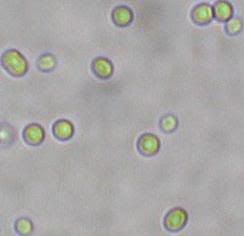Scientists sequence genome of bacterium that uses near infrared light for photosynthesis; could lead to creation of "super plants"
 An international team of scientists has sequenced the genome of a rare bacterium that harvests light energy by making an even rarer form of chlorophyll, chlorophyll d. Chlorophyll d absorbs "red edge", near infrared, long wave length light, invisible to the naked eye. The scientists think that if the genes responsible for this unique capacity were to be embedded into genetically altered higher plants, they could become super solar energy factories with a greatly improved photosynthetic efficiency - which would have "immense agricultural consequences". Findings are published in the Feb. 4, online edition of the Proceedings of the National Academy of Sciences.
An international team of scientists has sequenced the genome of a rare bacterium that harvests light energy by making an even rarer form of chlorophyll, chlorophyll d. Chlorophyll d absorbs "red edge", near infrared, long wave length light, invisible to the naked eye. The scientists think that if the genes responsible for this unique capacity were to be embedded into genetically altered higher plants, they could become super solar energy factories with a greatly improved photosynthetic efficiency - which would have "immense agricultural consequences". Findings are published in the Feb. 4, online edition of the Proceedings of the National Academy of Sciences.Boosting plants' photosynthetic efficiency is one of the most exciting research foci in biotechnology and bioenergy, because there is great room for improvement: plants currently convert only around 0.3 to 0.5% of incoming sunlight into energy, but in theory this can be doubled several times. The consequences of such an intervention would obviously be enormous. Some scenarios show that breakthroughs in this field could make biomass and biofuels virtually 'endless' sources of green energy.
The extension of Chl d absorption into the near infrared, beyond the range of any other oxygenic photosynthetic organisms, could have immense agricultural consequences. If Chl d could be incorporated into higher plants, it has a potential capacity of increasing the energy conversion of sunlight by 5% compared to that of the Chl a-containing organisms. - Phototrophic Prokaryotic Sequencing ProjectPlants that harvest near infrared light would be quite futuristic and give them a bit of a cosmic feel. It is no coincidence that when astrobiologists, like the lead author of the paper, imagine what plants would look like on other planets, they point at this capacity of harvesting non-visible, near infrared and full infrared light (weirder types of photosynthesis with black plants are thinkable too). Dr Robert Blankenship of Washington University is part of a NASA working group based at the Jet Propulsion Laboratory called the Virtual Plant Laboratory. He and his colleagues are studying light that comes from stars and extrasolar planets to infer the composition of the atmosphere of exoplanets. At times they use their knowledge and imagination to guesstimate the properties of potential plant life in such other worlds. Now they see a glimpse of this bizarre universe, here on Earth, in the form of a bizarre bacterium.
 By absorbing near infrared light, the cyanobacterium Acaryochloris marina - which was only recently discovered and lives symbiotically under the belly of a type of sea squirt in the Great Barrier Reef -, competes with virtually no other plant or bacterium in the world for sunlight. As a result, its genome is massive for a cyanobacterium, comprising 8.3 million base pairs, and sophisticated. The genome is among the very largest of 55 cyanobacterial strains in the world sequenced thus far, and it is the first chlorophyll d - containing organism to be sequenced.
By absorbing near infrared light, the cyanobacterium Acaryochloris marina - which was only recently discovered and lives symbiotically under the belly of a type of sea squirt in the Great Barrier Reef -, competes with virtually no other plant or bacterium in the world for sunlight. As a result, its genome is massive for a cyanobacterium, comprising 8.3 million base pairs, and sophisticated. The genome is among the very largest of 55 cyanobacterial strains in the world sequenced thus far, and it is the first chlorophyll d - containing organism to be sequenced.Dr Blankenship, who is the Lucille P. Markey Distinguished Professor in Arts & Sciences and principal investigator of the project, said with every gene of Acaryochloris marina now sequenced and annotated, the immediate goal is to find the enzyme that causes a chemical structure change in chlorophyll d, making it different from primarily chlorophyll a, and b, but also from about nine other forms of chlorophyll.
The synthesis of chlorophyll by an organism is complex, involving 17 different steps in all. Some place near the end of this process an enzyme transforms a vinyl group to a formyl group to make chlorophyll d. This transformation of chemical forms is not known in any other chlorophyll molecules. - Dr Robert BlankenshipBlankenship said he and his collaborators have some candidate genes they will test. They hope to insert these genes into an organism that makes just chlorophyll a. If the organism learns to synthesize chlorophyll d with one of the genes, the mystery of chlorophyll d synthesis will be solved, and then the excitement will begin.
Blankenship and his colleagues from Washington, Arizona State University, and scientists from Australia and Japan received support from the National Science Foundation. Three Washington University undergraduate students and one graduate student participated in the project, as well as other research personnel.
Harvesting solar power through plants or other organisms that would be genetically altered with the chlorophyll d gene could make them solar power factories that generate and store solar energy.'Super plants'
Consider a seven-foot tall corn plant genetically tailored with the chlorophyll d gene to be expressed at the very base of the stalk, the researchers ask. While the rest of the plant synthesized chlorophyll a, absorbing short wave light, the base is absorbing "red edge" light in the 710 nanometer range. Energy could be stored in the base without competing with any other part of the plant for photosynthesis, as the rest only makes chlorophyll a. The altered corn using the chlorophyll d gene would become a "super plant" because of its enhanced ability to harness energy from the sun, the scientist say:
 energy :: sustainability :: biomass :: bioenergy :: biofuels :: energy crops :: photosynthesis :: efficiency :: chlorophyll :: infrared :: genomics :: biotechnology ::
energy :: sustainability :: biomass :: bioenergy :: biofuels :: energy crops :: photosynthesis :: efficiency :: chlorophyll :: infrared :: genomics :: biotechnology :: That model is similar to how Acaryochloris marina actually operates in the South Pacific, specifically Australia's Great Barrier Reef. Discovered just 11 years ago, the cyanobacterium lives in a symbiotic relationship with a sponge-like marine animal popularly called a sea squirt . The Acaryochloris marina lives beneath the sea squirt, which is a marine animal that lives attached to rocks just below the surface of the water. The cyanobacterium absorbs "red edge" light through the tissues of its pal the sea squirt.
The genome, said Blankenship, is "fat and happy".
Acaryochloris marina lies down there using that far red light that no one else can use. The organism has never been under very strong selection pressure to be lean and mean like other bacteria are. It's kind of in a sweet spot. Living in this environment is what allowed it to have such dramatic genome expansion. - Dr Robert BlankenshipBlankenship said that once the gene that causes the late-step chemical transformation is found and inserted successfully into other plants or organisms, that it could potentially represent a five percent increase in available light for organisms to use.
"We now have genetic information on a unique organism that makes this type of pigment that no other organism does," Blankenship added. "We don't know what all the genes do by any means. But we�ve just begun the analysis. When we find the chlorophyll d enzyme and then look into transferring it into other organisms, we'll be working to extend the range of potentially useful photosynthesis radiation."
Many plant biologists, biotechnologists and bioenergy experts think improving the photosynthetic efficiency of energy crops could be part of a hyper-efficient bioeconomy of the future. Currently, most plants have a convert only between 0.3 and 0.5 percent of the incoming sunlight into energy. But theoretically it is possible to increase this tenfold.
Many projections about the global bioenergy potential are based on the status quo - agriculture and technology as it is today. They do not take biotechnological breakthroughs into account even though they are being made frequently. This is so because (the effects of such) breakthroughs cannot be projected or predicted. But most of the researchers who have assessed the long term potential for bioenergy almost all agree: in a scenario of a highly improved photosynthetic efficiency of plants, the entire energy game would be altered radically, and biofuels and biomass would become virtually endless sources of energy.
Picture of Acaryochloris marina, credit: Phototrophic Prokaryotic Sequencing Project.
References:
[PNAS article not yet available at the time of writing].
Eurekalert: Bacterium sequenced makes rare form of chlorophyll - Living on "the red edge" - February 4, 2008.
Eurekalert: Scientists ponder plant life on extrasolar Earthlike planets - June 7, 2007.
Scott R. Miller, Sunny Augustine, Tien Le Olson, Robert E. Blankenship, Jeanne Selker, and A. Michelle Wood, "Discovery of a free-living chlorophyll d-producing cyanobacterium with a hybrid proteobacterial/cyanobacterial small-subunit rRNA gene", PNAS 2005 102: 850-855; published online before print as 10.1073/pnas.0405667102
Phototrophic Prokaryotic Sequencing Project: Cyanobacteria: Acaryochloris marina.
 --------------
--------------
 Mongabay, a leading resource for news and perspectives on environmental and conservation issues related to the tropics, has launched Tropical Conservation Science - a new, open access academic e-journal. It will cover a wide variety of scientific and social studies on tropical ecosystems, their biodiversity and the threats posed to them.
Mongabay, a leading resource for news and perspectives on environmental and conservation issues related to the tropics, has launched Tropical Conservation Science - a new, open access academic e-journal. It will cover a wide variety of scientific and social studies on tropical ecosystems, their biodiversity and the threats posed to them.









2 Comments:
Speaking of super plants
Here is an activity your readers would enjoy is to grow a TickleMe Plant from seeds and then watching the plant MOVE when Tickled! As a first grade teacher I no longer plant Lima beans, as the growing of this interactive plant, proved to be much more exciting and educational for my student's.
I found my supplies for a classroom kit at www.ticklemeplant.com but they also sell individual greenhouses with everything you need to grow your own TickleMe Plant from seeds. I assure you your kids will be more excited about gardening, and its just fun to watch the expressions of the faces of children (and even adults) when they see the plant close its leaves and droop when tickled,
Thanks for the post about TickleMe Plants. I ordered the greenhouse and can't wait to grow it and watch it move. I never heard of this plant before.
Post a Comment
Links to this post:
Create a Link
<< Home